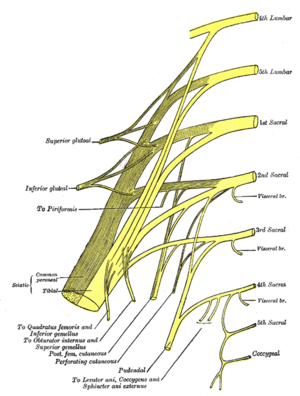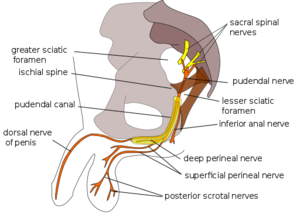Pudendal Nerve: Difference between revisions
No edit summary |
No edit summary |
||
| Line 6: | Line 6: | ||
== Description == | == Description == | ||
[[File:Sacral plexus.png|thumb|Sacral plexus with Pudendal nerve]] | [[File:Sacral plexus.png|thumb|Sacral plexus with Pudendal nerve]] | ||
The term 'Pudendal' comes from ( Latin pudenda, meaning “external genitals”, derived from pudendum, meaning "parts to be ashamed of<ref>Harper, Douglas. "Pudendum". Online Etymology Dictionary.</ref> | |||
The pudendal nerve is the main nerve of perineum, pelvic floor muscles and the external genitalia.<ref>Rojas-Gómez MF, Blanco-Dávila R, Tobar-Roa V, Gómez-González AM, Ortiz-Zableh AM, Ortiz-Azuero A. https://www.researchgate.net/publication/318085947_Regional_anesthesia_guided_by_ultrasound_in_the_pudendal_nerve_territory Colombian Journal of Anestesiology. 2017 Sep;45(3):200-9.</ref>Benjamin Alcock first described it in 1836 while researching the internal pudendal artery's path. | |||
The pudendal nerve is a mixed nerve having sensory, motor, and autonomic functions. | The pudendal nerve is a mixed nerve having sensory, motor, and autonomic functions. | ||
[[File:Pudendal nerve.svg.png|thumb|Branches of Pudendal nerve in Male]] | |||
=== Course === | === Course === | ||
| Line 17: | Line 22: | ||
=== Branches === | === Branches === | ||
There are three main branches of Pudendal nerve. They are | |||
== Function == | == Function == | ||
Revision as of 06:24, 27 June 2022
Original Editor - name here
Top Contributors - Manisha Shrestha, Lucinda hampton, Kim Jackson, Wendy Snyders and Cindy John-Chu
Description[edit | edit source]
The term 'Pudendal' comes from ( Latin pudenda, meaning “external genitals”, derived from pudendum, meaning "parts to be ashamed of[1]
The pudendal nerve is the main nerve of perineum, pelvic floor muscles and the external genitalia.[2]Benjamin Alcock first described it in 1836 while researching the internal pudendal artery's path.
The pudendal nerve is a mixed nerve having sensory, motor, and autonomic functions.
Course[edit | edit source]
- The nerve travels anterior to the piriformis muscle and then passes between the sacrotuberous and sacrospinous ligaments, which are analogous to a "clamp" or "lobster claw," "pinching" or impinging on the nerve.
- Upon leaving this site, the nerve travels through the pudendal canal (Alcock canal) and divides into the perineal nerve, the dorsal nerve of the penis or clitoris, and the inferior rectal nerve.
Root[edit | edit source]
S2,S3,S4
Branches[edit | edit source]
There are three main branches of Pudendal nerve. They are
Function[edit | edit source]
Motor[edit | edit source]
Sensory[edit | edit source]
Clinical relevance[edit | edit source]
- Pudendal Neuralgia
- Pudental Nerve Entrapment Syndrome
- Pudental Nerve Injury
Assessment[edit | edit source]
History[edit | edit source]
Common causes for pudendal nerve injury include:
- Prolonged sitting (e.g., seamstress, computer operators, judges, concert pianists, locomotive engineers)
- Repetitive hip flexion (sports activities, exercising, jogging, cycling)
- Direct trauma includes falls, motor vehicle accidents, vaginal delivery and pelvic surgeries, especially when using mesh (eg: surgeries for urinary incontinences, total abdominal hysterectomy)
- Radiation therapy especially in males treated for prostate cancer and patients treated for rectal and gynecological cancers[4]
Pain Assessment[edit | edit source]
- Patient with pelvic pain (especially perineal and genital) with or without concurrent sexual, bladder, or bowel symptoms
- Gradual onset of pain except for acute trauma
- Pain is less in morning and progress with progression of the day
- Type of pain is usually burning pain , but may also experience tingling, aching, stabbing, and shock-like pain
- Pain aggravates while sitting and relieves when standing, lying down, or seated on a toilet.
- Pain distribution may be limited or extensive and may include the vulva, vagina, clitoris, perineum, and rectum in females; glans penis, scrotum, perineum, and rectum in males
- Other symptoms associated with PN include urinary frequency, urgency, symptoms mimicking interstitial cystitis, painful ejaculation, dyspareunia, painful nocturnal orgasms, and persistent sexual arousal.
- Foreign body sensation[5]
Physical Examination
- Sensory
- Motor
- Autonomic
Treatment[edit | edit source]
Resources[edit | edit source]
References[edit | edit source]
- ↑ Harper, Douglas. "Pudendum". Online Etymology Dictionary.
- ↑ Rojas-Gómez MF, Blanco-Dávila R, Tobar-Roa V, Gómez-González AM, Ortiz-Zableh AM, Ortiz-Azuero A. https://www.researchgate.net/publication/318085947_Regional_anesthesia_guided_by_ultrasound_in_the_pudendal_nerve_territory Colombian Journal of Anestesiology. 2017 Sep;45(3):200-9.
- ↑ Causes of Pudendal Neuralgia. Available from: https://www.youtube.com/watch?v=mLvwV_Tfas4 lasted accessed: 27th June 2022
- ↑ Soon-Sutton TL, Feloney MP, Antolak S. Pudendal neuralgia. InStatPearls [Internet] 2021 Jul 31. StatPearls Publishing.
- ↑ Kaur J, Singh P. Pudendal nerve entrapment syndrome.








